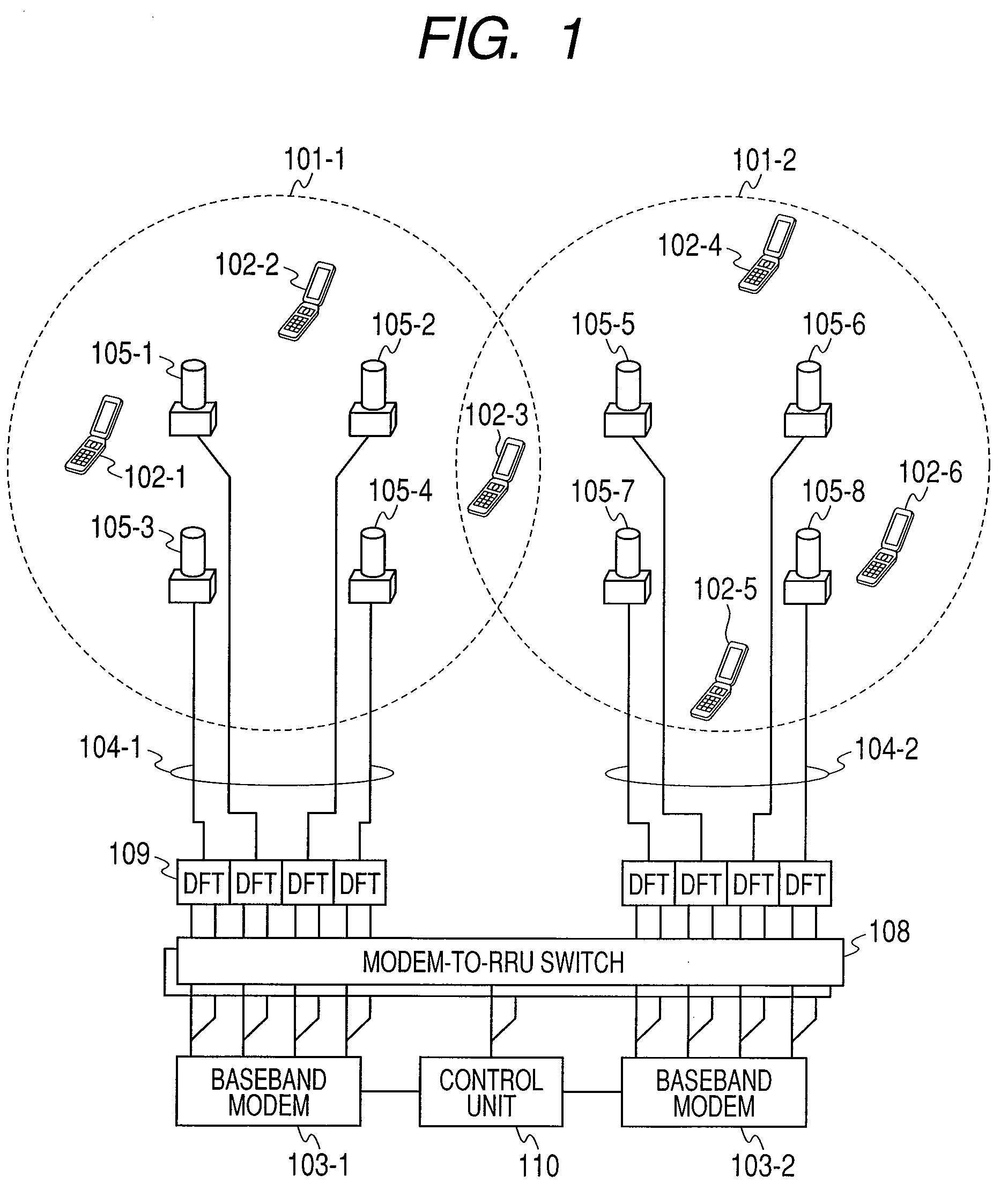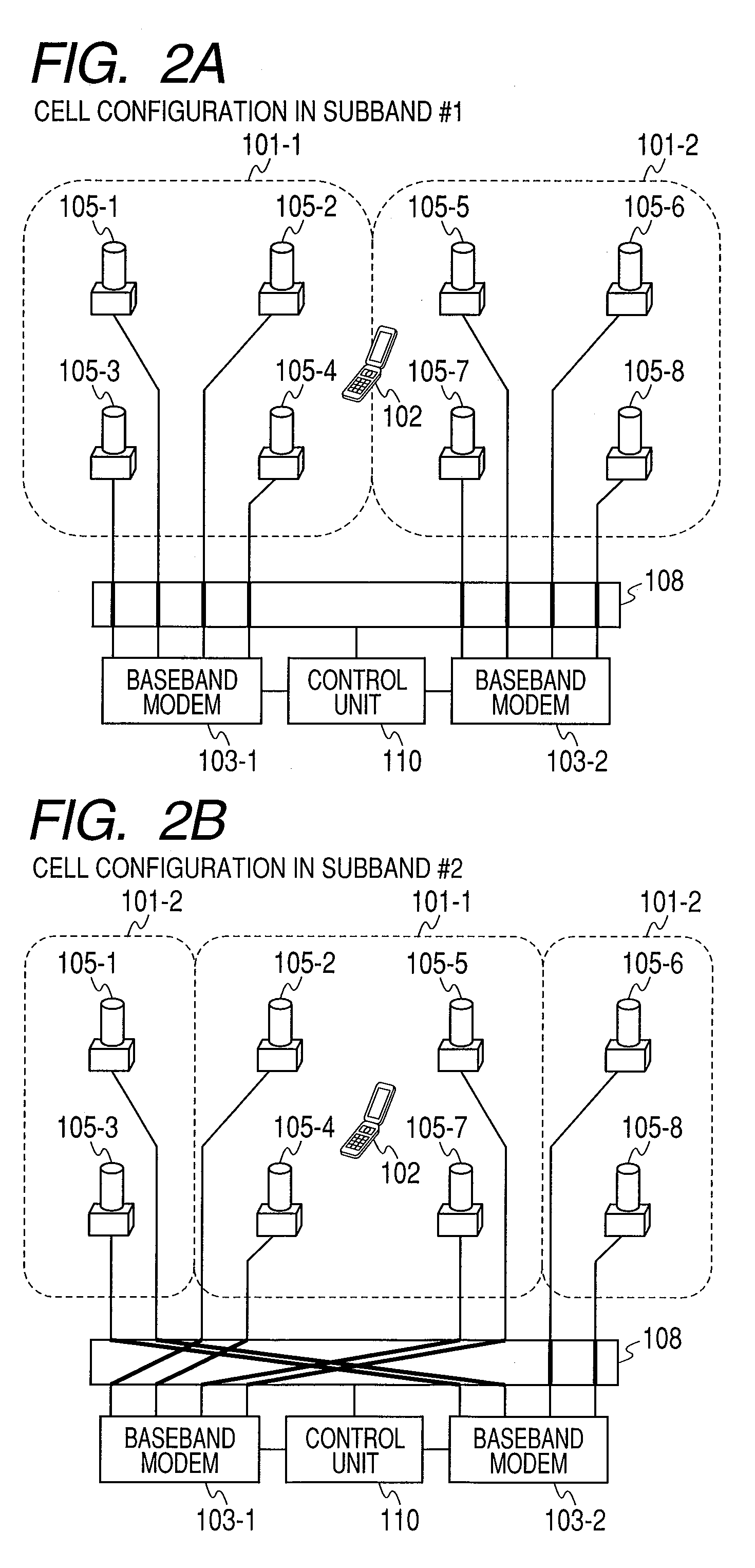Radio communications system
a radio communication and system technology, applied in the field of radio communications systems, can solve the problems of degrading the communication quality of the terminal located on the boundary of cells produced by the base stations, intercell interference between the base stations, etc., to reduce the number of baseband modems 103 in the entire system, reduce interference between cells, and induce the effect of communication quality degradation
- Summary
- Abstract
- Description
- Claims
- Application Information
AI Technical Summary
Benefits of technology
Problems solved by technology
Method used
Image
Examples
first embodiment
[0088]FIG. 1 is an explanatory diagram showing the configuration of a network system according to the present invention.
[0089]Cells 101-1 and 101-2, terminals 102-1 to 102-6, baseband modems 103-1 and 103-2, optical fibers 104-1 and 104-3, and front end portions 105-1 to 105-8 shown in FIG. 1 are identical with those in FIG. 38 or 39. The network system shown in FIG. 1 includes a modem-to-RRU switch 108, a DFT processing unit 109, and a control unit 110.
[0090]The baseband modem 103 shown in FIG. 1 has respective input / output ports allocated to a plurality of antennas, and one or plural base station modems 103 are arranged in the network system. The baseband modem 103 communicates a baseband signal for each of the subbands between the baseband modem 103 and the modem-to-RRU switch 108 (RRU: Remote Radio Unit), and also communicates a data bit series with a core network. Also, the modem 103 transmits traffic information for changing over the modem-to-RRU switch 108 to the control unit...
second embodiment
[0284]FIG. 29 is an explanatory diagram showing the configuration of a network system according to the present invention.
[0285]The first embodiment uses the OFDM radio communications system whereas the second embodiment shown in FIG. 29 uses the general multicarrier radio communications system. A difference from the configuration of the first embodiment resides in both ends of the optical fiber 104. When the optical fibers 104 are allocated to the signals of the respective carriers in the multicarrier radio communications system, individually, the radio communications system can be implemented by providing an optical modulator / demodulator and an electrical / optical converter which to each of the optical fibers. However, when the optical fiber is allocated to each of the carriers, because the costs for providing the optical fibers are increased, it is desirable to transmit the signals of the plural carriers by one optical fiber. For that reason, the radio communications system accordi...
third embodiment
[0288]FIG. 31 is an explanatory diagram showing the configuration of a network device according to the present invention.
[0289]The termination of the optical fibers 104 is the DFT processing units 109 in the first embodiment shown in FIG. 5, and the multicarrier coupling / separation units 111 in the second embodiment shown in FIG. 30.
[0290]In the configuration of the network device according to the third embodiment, each of the baseband modems 103 executes the signal processing of the subband being a control unit of the modem-to-RRU switch 108 at the plurality of antenna ports in a lump. According to the third embodiment, switching of each subband between the baseband modems 103 and the modem-to-RRU switches 108 is not required with the result that the array wiring in the same section is eased.
PUM
 Login to View More
Login to View More Abstract
Description
Claims
Application Information
 Login to View More
Login to View More - R&D
- Intellectual Property
- Life Sciences
- Materials
- Tech Scout
- Unparalleled Data Quality
- Higher Quality Content
- 60% Fewer Hallucinations
Browse by: Latest US Patents, China's latest patents, Technical Efficacy Thesaurus, Application Domain, Technology Topic, Popular Technical Reports.
© 2025 PatSnap. All rights reserved.Legal|Privacy policy|Modern Slavery Act Transparency Statement|Sitemap|About US| Contact US: help@patsnap.com



